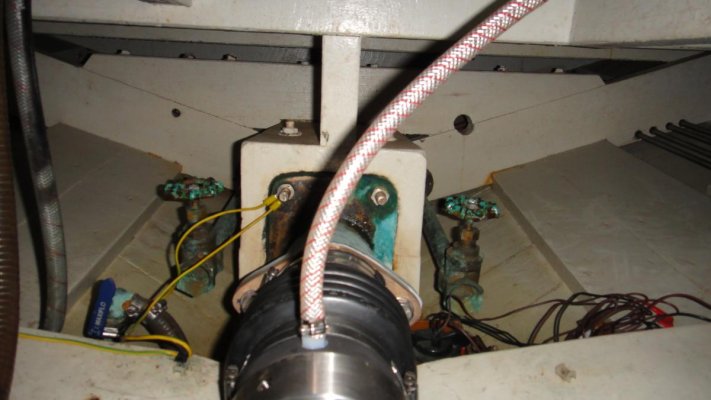Delfin
Grand Vizier
- Joined
- Jan 20, 2010
- Messages
- 3,821
I would very much appreciate the experts' opinion on a PYI shaft seal question. My wheel only turns around 400 rpm through the Twin disc, and I have gone a year or more with the vent closed off after burping the seal. The question is whether there is any reason not to keep it closed, or whether it should have water injected into it, or whether to route the hose attached to it to a higher location. The latter question relates to the fact that when powering at hull speed, the stern will sink low enough that the overflow attached to the tube will begin to fill up and overflow itself because it is not mounted high enough. It isn't practical to mount the overflow higher than it is, so if I fixed that, I would have to drill a hole through a steel bulkhead so as to be able to route the vent line to a location well above the waterline under all power conditions.
But I'm asking myself, why bother? At such low speeds I have never detected any heating of the water in the stern tube using an IR gun, and the only reason to think about injecting water is that when we pulled the shaft recently, the stern tube was full of crud. Presumably, if I injected sea water into the vent, this would be somewhat reduced, but again, do I care? By injecting fresh sea water into the stern tube, won't I accelerate corrosion because the water injected would have higher oxygen than the stagnant water that probably sits in it now. Or, should I just extend the vent so it doesn't overflow? Or should I just keep the darn thing plugged and find something else to worry about? Like all those logs Marin says are out there......
One more question - do these jeans make my butt look big?
But I'm asking myself, why bother? At such low speeds I have never detected any heating of the water in the stern tube using an IR gun, and the only reason to think about injecting water is that when we pulled the shaft recently, the stern tube was full of crud. Presumably, if I injected sea water into the vent, this would be somewhat reduced, but again, do I care? By injecting fresh sea water into the stern tube, won't I accelerate corrosion because the water injected would have higher oxygen than the stagnant water that probably sits in it now. Or, should I just extend the vent so it doesn't overflow? Or should I just keep the darn thing plugged and find something else to worry about? Like all those logs Marin says are out there......
One more question - do these jeans make my butt look big?


